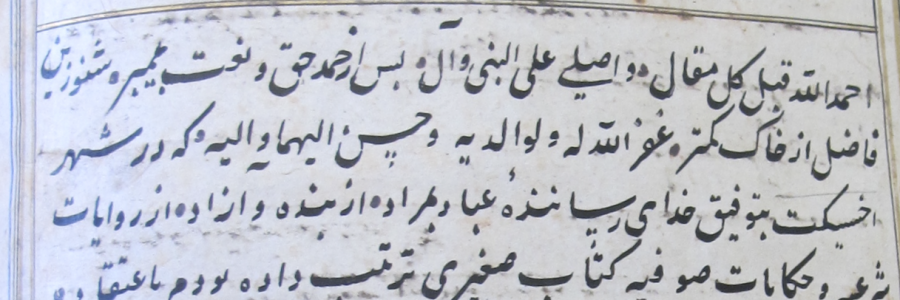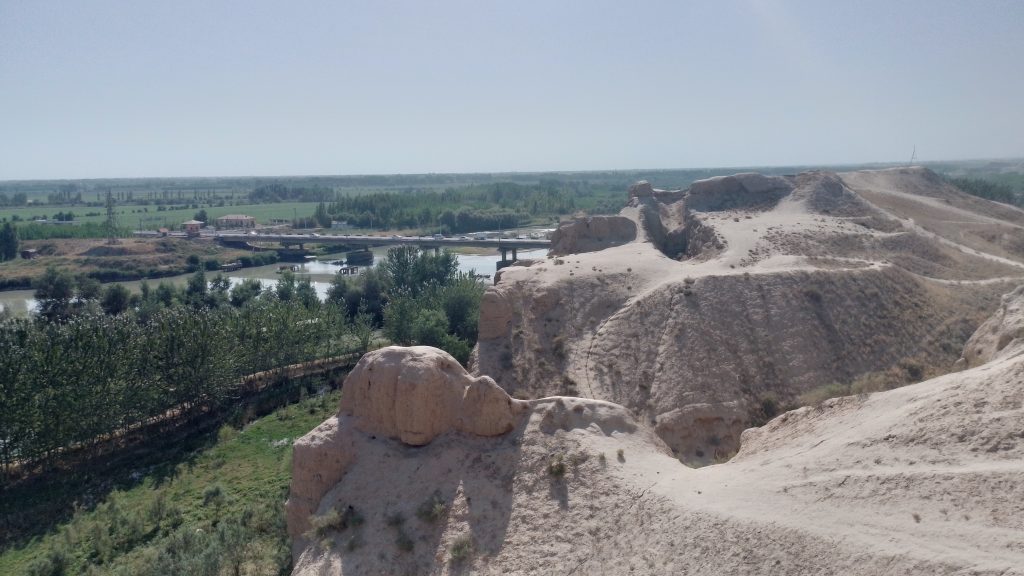
A Remnant from the Ruined City of Akhsikath, Uzbekistan: Another Rare Persianate Manuscript Belonging to Erpenius
As I have previously discussed,[1] Cambridge University Library (henceforth: CUL) has housed the main part of the personal library of the famous Dutch Orientalist, Thomas Erpenius (d. 1624) since June 1632. Almost all his manuscripts at CUL are important in terms of content, language, and physical features. Through examining this collection, one may notice that not only he was in possession of royal manuscripts, but he himself, was also the scribe of rare Arabic, Turkish, Persian, and Malay accounts and materials.
It has always been difficult for me to rank these sources in terms of importance and influence. Nonetheless, one manuscript may add extra information about the dark side of history by shedding light on the literary and social culture of a region which does not actively exist on Earth anymore. This is the manuscript CUL MS Gg.2.13 (which measures 25.5 x 20 cm and has 407 folios) which was written in Akhsikath in Uzbekistan in the 16th century CE. While it was an important city in the past, no one has lived in Akhsikath for centuries. In this regard, scholars generally rely on numismatic and other archaeological data to understand the history of this part of Central Asia. Akhsikath was a mint-town and the capital of Farganah (فرغانه).[2] It is widely known that this city was to some extent destroyed and changed during the Mongol invasion in the 13th century. It, however, continued its life up until the early 17th century, when after a strong earthquake around the early 1620s, and perhaps further subsequent social disasters, its “inhabitants decided to leave the city and found their new home in the modern Namangan area.”[3] At the moment, Akhsikath is a well-known archaeological site replete with mysteries and yielding new information about ancient, medieval and pre-modern Central Asia. Wilhelm Barthold (Vasily Vladimirovich Bartol) explains:
Akhsikath was in the 4th (10th) century the capital of Farghana; under Babar.[4] It was the second of the large towns and was then called Akhsi […] According to Babar, Akhsikath was situated on the right bank of the river Sir, near the place where the Kasan-sai joins it. At present, there still exist (near the village Akhsi and Shahand) the ruins of the old citadel (Iski Akhsi, 1000 steps from west to east, 600 steps from north to south, about 150 feet above the level of the water of the Sir; explored in the year 1885 by Professor Veselovsky from St. Petersburg) […].[5]
It is also said that “of the many towns, large and small, in Ferghana in the tenth century under the Samanids, Akhsikath (then the region’s capital) was considered the most important, followed by Kuba and Ush.”[6]

Thus, MS Gg.2.13, as a local product of Akhsikath, seems potentially valuable for historians of Central Asia. It is a Persianate manuscript produced by a local resident of Akhsikath who began writing this manuscript in 976 AH/circa 1569, a few years after finishing a shorter treatise on law and Sufism in 970AH/circa 1563CE. He titled the manuscript Gharāyib al-Masāʾil (‘Wondrous Accounts and Points’) (f. 2).
The whole volume is divided into forty chapters. The structure of the work, including citations and direct quotations from several authors affiliated with different Muslim schools of thought, is similar to other ethical-legal text produced throughout Central and South Asia in the 15th and 16th centuries CE.[7] But the manuscript includes interesting accounts, which one may rarely come across in other Persianate sources from Uzbekistan. One of them, for example, is an indication of the account of Farīd al-Dīn ʿAṭṭār, perhaps based on Jami’s Nafahat al-Uns:
گویند سبب توبه شیخ فرید الدین عطار قدس الله سره آن بود که روزی در دکان عطاری مشغول و مشعوف بمعامله بود. درویشی بآنجا رسید. چند شیء الله گفت. وی بدرویش بپرداخت. درویش گفت: ای خواجه تو چگونه خواهی مُرد؟ عطار گفت: چنانکه تو خواهی مُرد. درویش گفت: تو همچو من میتوانی مُرد؟ عطار گفت: بلی. درویش کاسه چوبین داشت زیر سر نهاد و گفت: الله، جان بداد. عطار را حال متغیّر شد و دکان بر هم زد و باین طریق در آمد.
وی مرید شیخ مجدالدین بغدادی است رحمة الله، و بعضی گفته اند که وی اویسی بوده است. و در سخنان مولانا جلال الدین رومی قدس سره مذکور است که نور منصور بعد از صد و پنجاه سال بروح فرید الدین عطار تجلی کرد و مرئی او شد. و مولانا رحمة الله عنایت نموده اند و در تعریف او چنین فرموده اند که: نظم. «من آن مولای رومی ام که در عالم نمی گنجم، بدین شوکت که میبینی غلام شیخ عطارم».
It is said that the main thing prompting Shaykh Farīd al-Dīn ʿAṭṭār, God Purifies his tomb, to repent (to leave his job to become a Sufi) happened when he was preoccupied with business at his shop. A Dervish approached there, asking for something for the sake of God. ʿAṭṭār paid [some amounts] to the Dervish. [then] the Dervish asked him: “O Khājeh, how will you die?”. “I will die like you” ʿAṭṭār responded. The Dervish asked [again]: “Can you really die like me?” ‘Attar said: “Yes”. The Dervish put his wooden bowl (commonly used by some Dervishes) under his head [viz., he lay down], and said “Allah”, and then he died. [Following this] ‘Attar underwent a radical transformation, left his shop and put his step into this path (ṭariqat). He was a disciple of Majd al-Dīn Baghdādī, God’s mercy upon him. And some have stated that he was a follower of Uwaisī Sufism. And it has been mentioned in the accounts of Maulana Jalāl al-Dīn Rūmī, God Purifies his tomb, that “after one hundred and fifty years, the light of Manṣūr [al-Ḥallāj] was manifested upon the spirit of Farīd al-Dīn ʿAṭṭār so he became his reincarnation. And Maulana [Rūmī], God’s mercy upon him, said a poem about ʿAṭṭār praisefully: “I am the Maula of Rūm for whom this world is very small; despite having such a glory, I am a servant of Shaykh ʿAṭṭār”.
This manuscript also contains allusions to Persianate Qur’an commentaries like Tafsīr-i Zāhidī by Imam Aḥmad bin Ḥasan Darvāzajakī from Bukhara, the Great Khorasan in the 6thAH/12th century and Tafsīr-i Cahrkhī by Yaʿqūb Charkhī (d. c. 1447 CE), one of the influential Sufi commentators from the Balkh‐Bukhara region.
Fāḍil Muḥammad bin Pīr-Darwīsh, apparently the main author, ends his colophon with a couplet indicating the date of the manuscript (f.407r):
این نسخه که او بگفته در اخسیکت
در نهصد و هفتاد و نهم گشت تمام
"This work which has been copied in Akhsikath Has been finished in 979 AH/1572 CE"
The text on each page is framed with blue, black and gold lines until folio 303v.
It should also be noted that the manuscript was in the possession of Ākhond Mollā Ṣādik[8] whose rubaʿī in Nastaʿlīq is found on the first folio:
تا چند دلم طریق عصیان بو[…]
پیوسته حدیث عشق خوبان گوید
گواه که گر من گناهم سوزد
گو اشک که مام (؟) سیاهم شویَد
Given that Ms. Gg.2.13 was produced in Akhsikath, a significant historical city in the heart of the Persianate World, and also a few decades before the earthquake, it may make a significant contribution to our knowledge, answering a set of questions about social and political status of the region before its disappearance and prolonged silence. To fill this gap, I have been working with a number of Persian linguists and philologists (including Dr. Azar Mirzaei) on a Persian edition and English translation of the text, which will be completed in the near future.
By Dr Majid Daneshgar, Former Munby Fellow, Associate Professor of Area Studies, Center for South East Asian Studies, Kyoto University, Japan.
[1] For a series of my articles on Erpenius’ Library, see: https://specialcollections-blog.lib.cam.ac.uk/?author=70. My thanks go to Professor Chika Obiya, CSEAS, Kyoto University, for providing me with important information and references for this blogpost.
[2] Eugene Leggett, Notes on the Mint-towns and Coins of the Mohamedans from the Earliest Period of the Present Time With Map and a Table Showing the Dinars, Dirhems and Fulus of the Amawee and Abasee Khaleefehs from the Year 79 to 332 A.H. (London: Stevens & sons, 1885), 5.
[3] For more general information, see; https://adrastravel.com/uzbekistan/namangan/. Also, https://uzbekistan.travel/en/o/ancient-city-of-akhsikent/ . On historical aspects of this city, see: Ali Mir Ansari , “Akhsikath”, The Centre for the Great Islamic Encyclopaedia (Tehran: The Centre for the Great Islamic Encyclopaedia, 1399/2020): https://www.cgie.org.ir/fa/article/228676/اخسیکت
[4] Also, Babur.
[5] W. Barthold, “Akhsikath”, in E.J. Brill’s First Encyclopaedia of Islam 1913-1936. A – Bābā Beg, vol. 1, edited by Edited by M. Th. Houtsma, T. W. Arnold, R. Basset and R. Hartmann (Leiden: Brill, 1993), 234. Regarding the devastating earthquake, see: Bakhtiyor Askarovich Ruzinov, “Akhsikent Earthquake,” Texas Journal of Multidisciplinary Studies 9 (2022): 209-212.
[6] Unesco’s History of Civilizations of Central Asia (1992): 140
[7] E.g., see Majmuʿih-yi Khānī from India. Also, see Majid Daneshgar, “Persianate Fiqh in Indonesia: Majmuʿih-yi Khānī as a Rare Legal Manuscript in a Cosmopolitan Context,” International Journal of Islam in Asia 2/2 (2023): 144-169 https://doi.org/10.1163/25899996-20223006
[8] “Ākhond” used to be a commonly known title among the Turkic communities of Central Asia.

Thank you. I was not familiar with this collection, even though I once worked in Cambridge. I look forward to its publication. I visited Akhsi briefly in 2000, and hope to return this year.
Stephen F. Dale